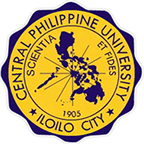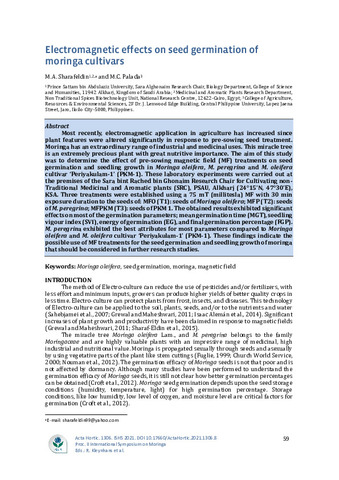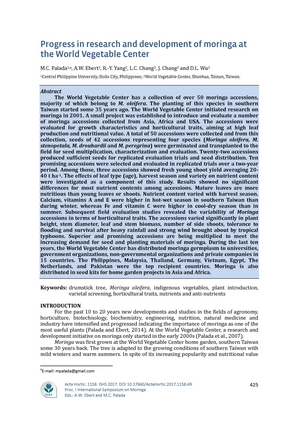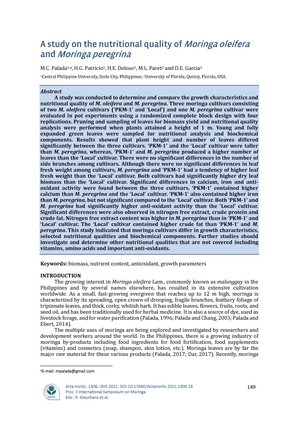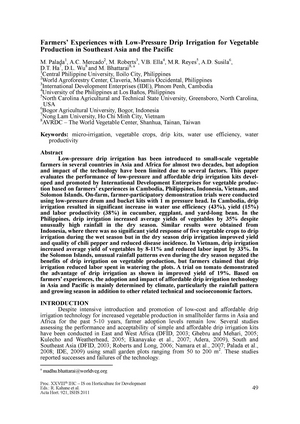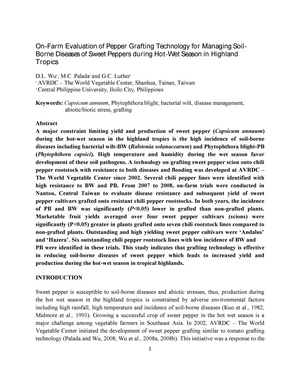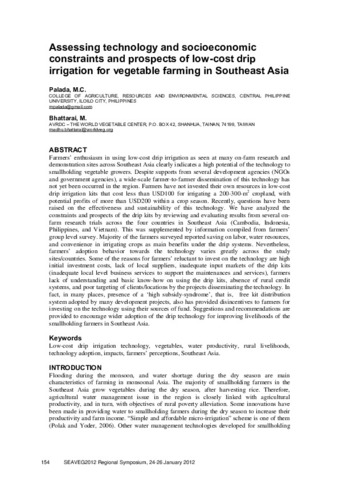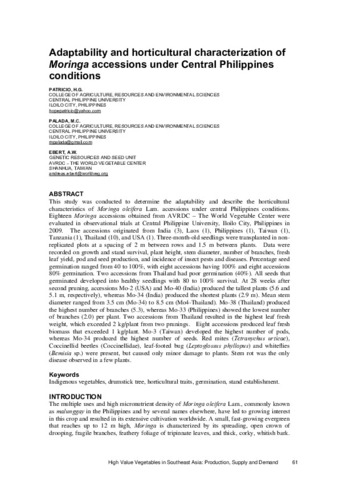Search
Now showing items 1-10 of 16
Electromagnetic effects on seed germination of moringa cultivars
(International Society for Horticultural Science, 2021-04)
Most recently, electromagnetic application in agriculture has increased since plant features were altered significantly in response to pre-sowing seed treatment. Moringa has an extraordinary range of industrial and medicinal uses. This miracle tree is an extremely precious plant with great nutritive importance. The aim of this study was to determine the effect of pre-sowing magnetic field (MF) treatments on seed germination and seedling growth in Moringa oleifera, M. peregrina and M. oleifera cultivar 'Periyakulam-1' (PKM-1). These laboratory experiments were carried out at the premises of the Sara bint Rached bin Ghonaim Research Chair for Cultivating non-Traditional Medicinal and Aromatic plants (SRC), PSAU, Alkharj (24°15'N, 47°30'E), KSA. Three treatments were established using a 75 mT (millitesla) MF with 30 min exposure duration to the seeds of: MFO (T1): seeds of Moringa oleifera; MFP (T2): seeds of M. peregrina; MFPKM (T3): seeds of PKM 1. The obtained results exhibited significant effects on most of the germination parameters; mean germination time (MGT), seedling vigour index (SVI), energy of germination (EG), and final germination percentage (FGP). M. peregrina exhibited the best attributes for most parameters compared to Moringa oleifera and M. oleifera cultivar 'Periyakulam-1' (PKM-1). These findings indicate the possible use of MF treatments for the seed germination and seedling growth of moringa that should be considered in further research studies....
Moringa - a vegetable tree for improved nutrition, health and income of smallholder farmers
(International Society for Horticultural Science, 2017-05-09)
Moringa (Moringa oleifera) is a perennial softwood vegetable tree widely grown in the tropics of Asia, Latin America, and sub-Saharan Africa. Most parts of the tree are edible. The leaves and flowers are eaten as salad, as cooked vegetables, added to soups and sauces, or used to make tea. The young, tender pods - known as drumsticks - are highly valued as a vegetable in Asia. Moringa is nutrient-dense and rich in essential micronutrients and vitamins as well as antioxidants and bioavailable iron. According to data available at AVRDC's Nutrition Lab, moringa exceeds the micronutrient content of tomato, based on 100 g FW, by a factor of 9 to 38: β-carotene content - 15.28 mg (×38); vitamin C - 459 mg (×24); vitamin E - 25.25 mg (×22); iron - 10.09 mg (×19); folates - 93 µg (×19); antioxidant activity - 2858 TE (×9). Moringa is also rich in protein: 100 g of fresh moringa leaves contain 9.4 g of protein comprising all essential amino acids in nutritionally balanced proportions. Boiling fresh moringa leaves and dried powder in water enhances aqueous antioxidant activity and increases bioavailable iron by a factor of 3. Dried leaf powder is processed into moringa capsules and used as a dietary supplement. Depending on the genotype, leaf fresh weight of the first two harvests ranges from 560 g to 2.3 kg plant<sup>-1</sup>. Total fresh matter yield at first harvest (leaves and young shoots) depends on plant density and varies from 19.6 to 78 t ha<sup>-1</sup> with a plant density of 95,000 and 1 million plants, respectively. Moringa has great potential to generate income for smallholder farmers and to enhance environmental services by controlling soil and wind erosion, and by providing shade and clean water. Given its multiple uses and wide range of adaptability, moringa is an ideal crop for sustainable food production....
Progress in research and development of moringa at the World Vegetable Center
(International Society for Horticultural Science, 2017-05-09)
The World Vegetable Center has a collection of over 50 moringa accessions, majority of which belong to M. oleifera. The planting of this species in southern Taiwan started some 35 years ago. The World Vegetable Center initiated research on moringa in 2001. A small project was established to introduce and evaluate a number of moringa accessions collected from Asia, Africa and USA. The accessions were evaluated for growth characteristics and horticultural traits, aiming at high leaf production and nutritional value. A total of 50 accessions were collected and from this collection, seeds of 42 accessions representing four species (Moringa oleifera, M. stenopetala, M. drouhardii and M. peregrina) were germinated and transplanted to the field for seed multiplication, characterization and evaluation. Twenty-two accessions produced sufficient seeds for replicated evaluation trials and seed distribution. Ten promising accessions were selected and evaluated in replicated trials over a two-year period. Among those, three accessions showed fresh young shoot yield averaging 20-40 t ha<sup>-1</sup>. The effects of leaf type (age), harvest season and variety on nutrient content were investigated as a component of this study. Results showed no significant differences for most nutrient contents among accessions. Mature leaves are more nutritious than young leaves or shoots. Nutrient content varied with harvest season. Calcium, vitamins A and E were higher in hot-wet season in southern Taiwan than during winter, whereas Fe and vitamin C were higher in cool-dry season than in summer. Subsequent field evaluation studies revealed the variability of Moringa accessions in terms of horticultural traits. The accessions varied significantly in plant height, stem diameter, leaf and stem biomass, number of side shoots, tolerance to flooding and survival after heavy rainfall and strong wind brought about by tropical typhoons. Superior and promising accessions are being multiplied to meet the increasing demand for seed and planting materials of moringa. During the last ten years, the World Vegetable Center has distributed moringa germplasm to universities, government organizations, non-governmental organizations and private companies in 15 countries. The Philippines, Malaysia, Thailand, Germany, Vietnam, Egypt, The Netherlands, and Pakistan were the top recipient countries. Moringa is also distributed in seed kits for home garden projects in Asia and Africa....
A study on the nutritional quality of Moringa oleifera and Moringa peregrina
(International Society for Horticultural Science, 2021-04-15)
A study was conducted to determine and compare the growth characteristics and nutritional quality of M. oleifera and M. peregrina. Three moringa cultivars consisting of two M. oleifera cultivars (‘PKM-1’ and ‘Local’) and one M. peregrina cultivar were evaluated in pot experiments using a randomized complete block design with four replications. Pruning and sampling of leaves for biomass yield and nutritional quality analysis were performed when plants attained a height of 1 m. Young and fully expanded green leaves were sampled for nutritional analysis and biochemical components. Results showed that plant height and number of leaves differed significantly between the three cultivars. ‘PKM-1’ and the ‘Local’ cultivar were taller than M. peregrina, whereas, ‘PKM-1’ and M. peregrina produced a higher number of leaves than the ‘Local’ cultivar. There were no significant differences in the number of side branches among cultivars. Although there were no significant differences in leaf fresh weight among cultivars, M. peregrina and ‘PKM-1’ had a tendency of higher leaf fresh weight than the ‘Local’ cultivar. Both cultivars had significantly higher dry leaf biomass than the ‘Local’ cultivar. Significant differences in calcium, iron and anti-oxidant activity were found between the three cultivars. ‘PKM-1’ contained higher calcium than M. peregrina and the ‘Local’ cultivar. ‘PKM-1’ also contained higher iron than M. peregrina, but not significant compared to the ‘Local’ cultivar. Both ‘PKM-1’ and M. peregrina had significantly higher anti-oxidant activity than the ‘Local’ cultivar. Significant differences were also observed in nitrogen free extract, crude protein and crude fat. Nitrogen free extract content was higher in M. peregrina than in ‘PKM-1’ and ‘Local’ cultivar. The ‘Local’ cultivar contained higher crude fat than ‘PKM-1’ and M. peregrina. This study indicated that moringa cultivars differ in growth characteristics, selected nutritional qualities and biochemical components. Further studies should investigate and determine other nutritional qualities that are not covered including vitamins, amino acids and important anti-oxidants....
Farmers’ experiences with low-pressure drip irrigation for vegetable production in Southeast Asia and the Pacific
(International Society for Horticultural Science, 2011-12-31)
Low-pressure drip irrigation has been introduced to small-scale vegetable farmers in several countries in Asia and Africa for almost two decades, but adoption and impact of the technology have been limited due to several ...
Improving smallholder dry season vegetable production through increased water productivity with low cost drip irrigation technology in Cambodia
(International Society for Horticultural Science, 2011-12-31)
In rainfed cropping systems limited water supply is a major constraint for increased crop production during the dry season. The use of affordable drip irrigation systems can increase crop yield, water use efficiency, and labor productivity in dry season vegetable production. Farmer participatory research was conducted in Cambodia during the 2008 dry season to evaluate the performance and benefits of a low-cost drip irrigation system for improving small-scale vegetable production. The effect of integrating improved soil nutrient management through fertilizer deep placement on crop yield and economic returns were determined for selected vegetable crops. Compared with traditional practice of hand-watering, drip irrigation increased yield of chili (Capsicum annuum), cucumber (Cucumis sativus), and eggplant (Solanum melongena) by almost 50%, but reduced average net income by 25%. Drip irrigation decreased water use by 33%, and increased water use efficiency by 63% and labor productivity by 74%. The use of fertilizer deep placement with drip irrigation resulted in higher yield (18%) compared with commercial NPK fertilizer irrespective of irrigation methods. Significant response was shown in yard-long bean (Vigna unguiculata var. sesquipedales) with 35% yield increase and 50% increase in net income. Under drip irrigation the use of fertilizer deep placement reduced water use by 48%, increased water use efficiency by 70% and labor productivity by 78%. This study demonstrated the potential benefit of low-cost drip irrigation and fertilizer deep placement for improving smallholder vegetable production in Cambodia during the dry season through higher yield, increased water use efficiency, and higher economic returns and labor productivity compared with farmers’ traditional practice of hand-watering and fertilizer application....
On-farm evaluation of pepper grafting technology for managing soil-borne diseases of sweet peppers during hot-wet season in highland tropics
(International Society for Horticultural Science, 2012-08-31)
A major constraint limiting yield and production of sweet pepper (Capsicum annuum) during the hot-wet season in the highland tropics is the high incidence of soil-borne diseases including bacterial wilt-BW (Ralstonia solanacearum) and Phytophthora blight-PB (Phytophthora capsici). High temperature and humidity during the wet season favor development of these soil pathogens. A technology on grafting sweet pepper scion onto chili pepper rootstock with resistance to both diseases and flooding was developed at AVRDC – The World Vegetable Center since 2002. Several chili pepper lines were identified with high resistance to BW and PB. From 2007 to 2008, on-farm trials were conducted in Nantou, Central Taiwan to evaluate disease resistance and subsequent yield of sweet pepper cultivars grafted onto resistant chili pepper rootstocks. In both years, the incidence of PB and BW was significantly (P<0.05) lower in grafted than non-grafted plants. Marketable fruit yields averaged over four sweet pepper cultivars (scions) were significantly (P<0.05) greater in plants grafted onto seven chili rootstock lines compared to non-grafted plants. Outstanding and high yielding sweet pepper cultivars were ‘Andalus’ and ‘Hazera’. Six outstanding chili pepper rootstock lines with low incidence of BW and PB were identified in these trials. This study indicates that grafting technology is effective in reducing soil-borne diseases of sweet pepper which leads to increased yield and production during the hot-wet season in tropical highlands....
Horticultural characterization of AVRDC moringa germplasm in the Philippines and Taiwan
(International Society for Horticultural Science, 2015-12-06)
The major objective of this study was to evaluate a subset of the AVRDC Moringa oleifera germplasm collection for important horticultural traits in the Philippines and Taiwan. The 18 AVRDC moringa accessions originated from India, Laos, Philippines, Taiwan, Tanzania, Thailand and USA. Three-month-old seedlings were transplanted onto single-row raised beds spaced 1.5 m apart. Plants were arranged in a randomized block design with three replications. Data were collected on plant height, stem diameter, number of branches, canopy width, fresh and dry biomass (stems and leaves), days to flowering, and pod/seed yield. In Taiwan, one month after transplanting four accessions attained a plant height of above 1 m. Number of side branches ranged from 9 to 14 per plant. Differences in plant height and stem diameter were significant at 70 days after transplanting (DAT). Tallest plants (2.9 m) were observed in LSQUOMo-35RSQUO from Tanzania while LSQUOMo-8RSQUO from Thailand produced the largest stem diameter (36 cm). Leaf fresh weight and dry biomass was highest (15.8 and 9.2 t ha<sup>-1</sup>, respectively) for LSQUOMo-35RSQUO at 70 DAT. Survival and stand count decreased after two strong typhoons and severe flooding in 2009 and 2010. In the Philippines, accessions LSQUOMo-2RSQUO (USA) and LSQUOMo-40RSQUO (India) produced the tallest plants 28 weeks after second pruning. Mean stem diameter ranged from 3.5 cm (LSQUOMo-34RSQUO) to 8.5 cm (LSQUOMo-4RSQUO). LSQUOMo-38RSQUO (Thailand) produced the highest number of branches. Two accessions from Thailand (LSQUOMo-4RSQUO and LSQUOMo-14RSQUO) resulted in the highest leaf fresh weight, which exceeded 20 t ha<sup>-1</sup> from two prunings, while LSQUOMo-29RSQUO (India) produced the highest dry leaf biomass. Most accessions tolerated waterlogged conditions with 60-100% plant survival stand count. The results indicate that there are moringa accessions with promising horticultural traits for the high rainfall climate of Southeast Asia....
Assessing technology and socioeconomic constraints and prospects of low-cost drip irrigation for vegetable farming in Southeast Asia
(AVRDC – The World Vegetable Center, 2013)
Farmers’ enthusiasm in using low-cost drip irrigation as seen at many on-farm research and demonstration sites across Southeast Asia clearly indicates a high potential of the technology to smallholding vegetable growers. ...
Adaptability and horticultural characterization of Moringa accessions under Central Philippines conditions
(AVRDC – The World Vegetable Center, 2013)
This study was conducted to determine the adaptability and describe the horticultural characteristics of Moringa oleifera Lam. accessions under central Philippines conditions. Eighteen Moringa accessions obtained from AVRDC – The World Vegetable Center were evaluated in observational trials at Central Philippine University, Iloilo City, Philippines in 2009. The accessions originated from India (3), Laos (1), Philippines (1), Taiwan (1), Tanzania (1), Thailand (10), and USA (1). Three-month-old seedlings were transplanted in nonreplicated plots at a spacing of 2 m between rows and 1.5 m between plants. Data were recorded on growth and stand survival, plant height, stem diameter, number of branches, fresh leaf yield, pod and seed production, and incidence of insect pests and diseases. Percentage seed germination ranged from 40 to 100%, with eight accessions having 100% and eight accessions 80% germination. Two accessions from Thailand had poor germination (40%). All seeds that germinated developed into healthy seedlings with 80 to 100% survival. At 28 weeks after second pruning, accessions Mo-2 (USA) and Mo-40 (India) produced the tallest plants (5.6 and 5.1 m, respectively), whereas Mo-34 (India) produced the shortest plants (2.9 m). Mean stem diameter ranged from 3.5 cm (Mo-34) to 8.5 cm (Mo4-Thailand). Mo-38 (Thailand) produced the highest number of branches (5.3), whereas Mo-33 (Philippines) showed the lowest number of branches (2.0) per plant. Two accessions from Thailand resulted in the highest leaf fresh weight, which exceeded 2 kg/plant from two prunings. Eight accessions produced leaf fresh biomass that exceeded 1 kg/plant. Mo-3 (Taiwan) developed the highest number of pods, whereas Mo-34 produced the highest number of seeds. Red mites (Tetranychus urticae), Coccinellid beetles (Coccinellidae), leaf-footed bug (Leptoglossus phyllopus) and whiteflies (Bemisia sp.) were present, but caused only minor damage to plants. Stem rot was the only disease observed in a few plants....
